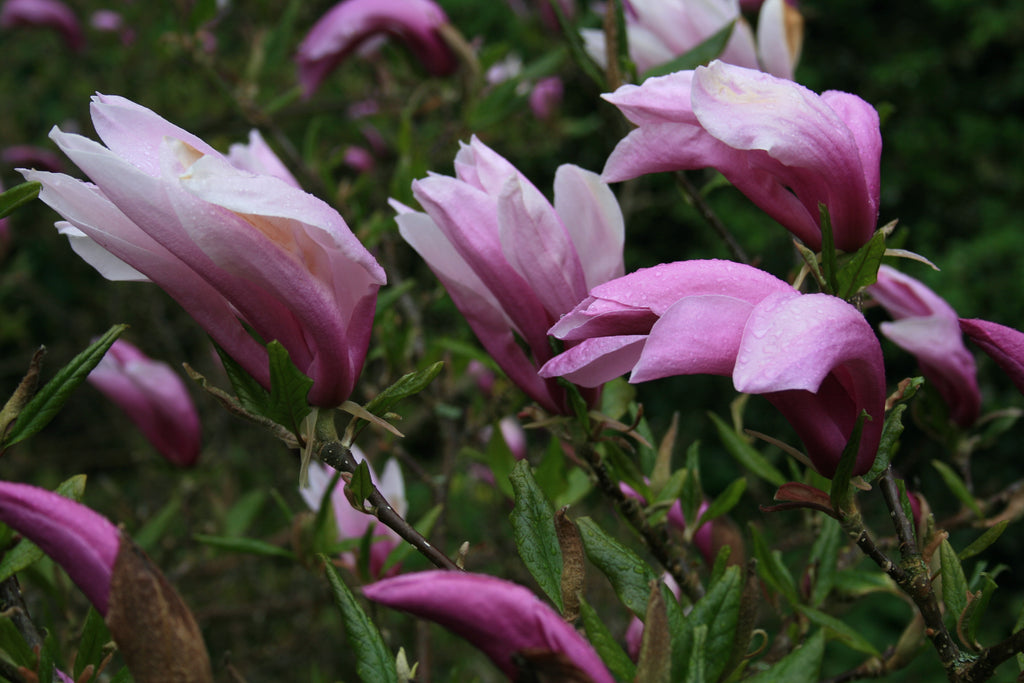

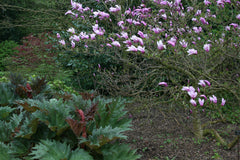

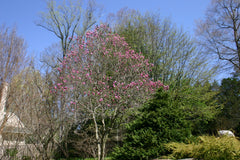
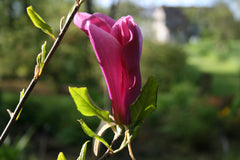
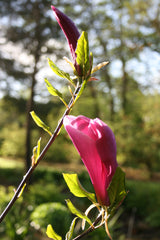
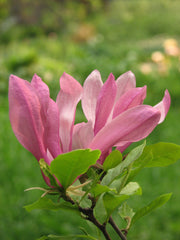
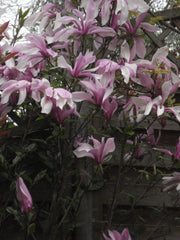
About this cultivar:
Magnolia 'Susan' is a cross between Magnolia liliiflora ‘Nigra’ and Magnolia stellata ‘Rosea’. It is part of the Little Girl series (‘Ann’, ‘Betty’, ‘Jane’, ‘Judy’, ‘Pinkie’, ‘Randy’, ‘Ricki’ and ‘Susan’) of hybrid magnolias that were developed at the USA National Arboretum in the mid-1950s by Francis DeVos and William Kosar. Plants in this series flower about 2-4 weeks later than Magnolia stellata and Magnolia soulangiana, thus reducing the risk of damage to flowers from late spring frosts.
Primarily noted for its compact shrubby habit, fragrant fuchsia flowers and late bloom, it is a slow-growing, deciduous shrub or small tree that blooms shortly before the foliage begins to appear. Flowers are purple-red or fuchsia, with paler tones inside. Flowers may sporadically repeat bloom in mid summer depending on how Susan feels!
- Position: Full sun, partial shade
- Soil: Almost any soil, grows well in Ballyrobert
- Flowers: April, May, June
- Other features: Grows well in Ballyrobert, Royal Horticultural Society Award of Garden Merit (RHS AGM)
- Hardiness: Fully hardy, grows well in Ballyrobert, H6 - Hardy in all of UK and northern Europe (-20 to -15°C)
- Habit: Clump forming, bushy
- Foliage: Deciduous
- Height: 200 - 350 cm (6.5 - 12 ft)
- Spread: 200 - 350 cm (6.5 - 12 ft)
- Time to full growth: 10 to 20 years
- Plant type: Herbaceous Perennial, shrub, tree
- Colour: Green, white
- Goes well with: Clematis
About this genus:
Magnolia is a large genus of over 200 species of deciduous or evergreen trees and shrubs in family Magnoliaceae. An ancient genus, appearing before bees did in the fossil record, the flowers are theorized to have evolved to encourage pollination by beetles! The natural range of Magnolia species is in east Asia and the Americas.
Historically, Charles Plumier, botanist to king Louis XIV of France, described a flowering tree from the island of Martinique in his Genera (1703), giving it the name Magnolia after the French botanist Pierre Magnol. Carl Linnaeus adopted the name in his first edition of Systema Naturae (1735). By the end of the 18th century, botanists and plant hunters exploring Asia began to name and describe the Magnolia species from China and Japan.
Like many large genus the flowers of many species are considered edible. The petals were/are pickled and used as a spicy condiment (in England) or to flavour rice and scent tea (in Asia). Some species grow quite large and are even harvested as timber (acuminata aka Yellow Poplar in the USA).
When gardening we are most often talking about the species stellata (star magnolia) and soulangeana (saucer magnolia) both of which flower quite early in the spring, before the leaves open. However other species are available: Some flower in late spring or early summer after the leaves have emerged, including virginiana (sweetbay magnolia) and grandiflora (southern magnolia, state flower of Louisiana and Mississippi). Most plants feature large simple leaves. And of course there are the hybrids….that do what they wanna do.
Primarily grown for the look of their amazingly stunningly wonderfully beautiful flowers, Magnolia have other virtues, it’s true. Preferring sun and part shade, disease and pest resistant, Magnolia will grow almost anywhere, even the heaviest clay. Given time to establish they will give hundreds of their scented flowers each year (that can come in every colour from white to purple to yellow). They will thrive in both the country and city and live up to 100 years. Not many genus can say all that.
Personally, I find the spring flowering types provide very visible interest at a time when there might not be much interest in the garden. The flowers visibly stand out all the more as they appear long before the plant itself begins to leaf. A bit like some ornamental Cherries (Prunus) you may say, but I find them much more flamboyant, perhaps much more Mag-nificent?!?!

